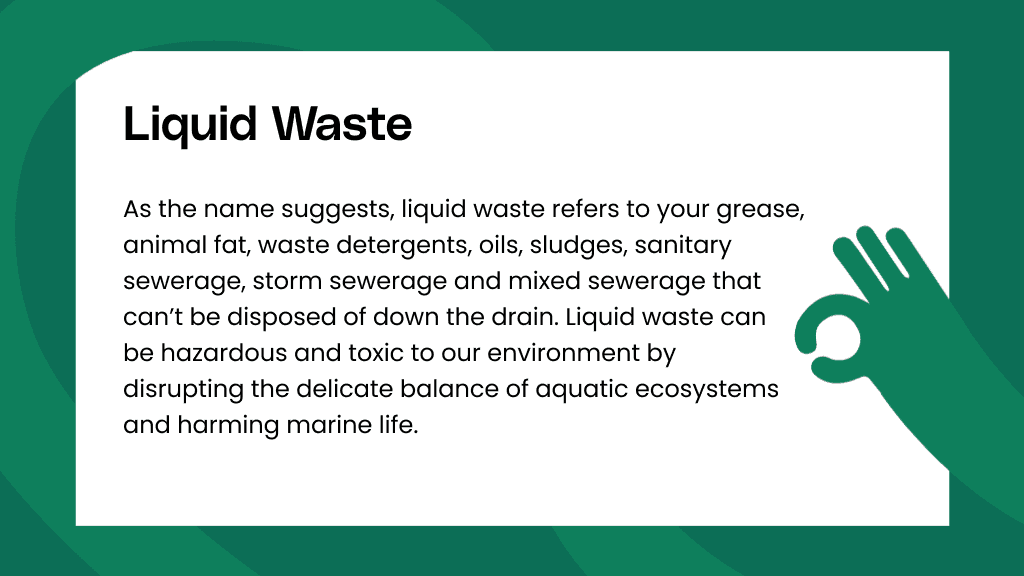6 Easy Facts About Reclaim Waste Explained
6 Easy Facts About Reclaim Waste Explained
Blog Article
7 Simple Techniques For Reclaim Waste
Table of ContentsNot known Facts About Reclaim WasteReclaim Waste Fundamentals ExplainedAll about Reclaim WasteWhat Does Reclaim Waste Do?What Does Reclaim Waste Mean?
Domestic sewer waste refers to the waste and products from a domestic septic container. The proper administration and disposal of domestic sewage waste need liquid waste to be transferred to a sewage treatment plant where the correct approaches and equipment are applied to cleanse and dispose of waste.
Commercial waste typically consists of prospective threats, such as combustible products or a mixture of fluid and strong waste items, and calls for an advanced and comprehensive disposal process. The disposal of industrial waste generally entails the purification of waste prior to transport to make certain risk-free and correct disposal. Hazardous waste is produced from results and runoff of commercial processes and manufacturing.
This sort of waste can not use the very same sewage monitoring transportation or procedures as septic or business liquids. The hazardous waste monitoring process needs the assessment and screening of liquid waste prior to it undertakes the disposal process (liquid waste disposal melbourne). Overflow waste is the fluid waste that originates from drainage and excess stormwater in extremely populated areas or cities
Overflow waste can cause contamination and flooding otherwise managed effectively. Discover more regarding sewage system cleaning and waste administration. Ensuring proper waste administration can protect against calamities and reduce environmental harm. Both individuals in residential settings and professionals in business or manufacturing sectors can gain from recognizing the processes and policies of fluid waste management.
The Basic Principles Of Reclaim Waste
Get in touch with PROS Providers today to find out about our waste monitoring and disposal services and the proper methods to take care of the liquid waste you generate.
(https://blogfreely.net/reclaimwaste1/yc311a58b1)Do you understand what takes place to your water when you disengage, purge the commode or drain pipes the washing device? No? Well, it's worth knowing. This so-called 'wastewater' is not just an important resource however, after treatment, will certainly be launched to our land, waterways or the ocean. Made use of water from commodes, showers, baths, cooking area sinks, laundries and industrial processes is referred to as wastewater.

water used to cool down equipment or tidy plant and equipment). Stormwater, a form of wastewater, is runoff that streams from agricultural and urban areas such as roofs, parks, yards, roadways, paths and gutters right into stormwater drains, after rain. Stormwater moves without treatment straight to regional creeks or rivers, eventually reaching the sea.
The Ultimate Guide To Reclaim Waste
In Queensland, a lot of wastewater is dealt with at sewer therapy plants. Wastewater is carried from residential or commercial websites via a system of sewers and pump terminals, recognized as sewerage reticulation, to a sewage therapy plant.
The Department of Natural Resources advises city governments about managing, operating and maintaining sewerage systems and therapy plants. In unsewered locations, city governments might call for householders to mount specific or home sewage therapy systems to deal with domestic wastewater from bathrooms, kitchens, you can look here bathrooms and washings. The Division of Natural Resources authorises making use of household systems when they are proven to be efficient.
In some new neighborhoods, treatment of some stormwater to eliminate clutter, sand and gravel has begun using gross pollutant traps. Wastewater therapy happens in 4 phases: Gets rid of solid matter.
Utilizes little living organisms understands as micro-organisms to break down and remove continuing to be dissolved wastes and fine particles. Micro-organisms and wastes are included in the sludge.
About Reclaim Waste
Nutrient removal is not readily available at all sewage treatment plants due to the fact that it requires pricey specialist tools. Clear liquid effluent produced after treatment might still have disease-causing micro-organisms - liquid waste removal melbourne.

This normally implies wastewater needs to be dealt with or contaminants removed before it can be discharged to rivers. Many wastewater flows into the sewage system. Under the Act, neighborhood governments administer authorizations and permits for environmentally relevant tasks (Ages) including wastewater releases that might have a regional impact. The division provides authorizations and licences to Ages entailing wastewater releases that may have a regional or statewide influence.
More About Reclaim Waste
Tracking provides factual details regarding water top quality and can verify that licence conditions are being satisfied. The information gotten with monitoring supplies the basis for making water high quality choices.
Report this page